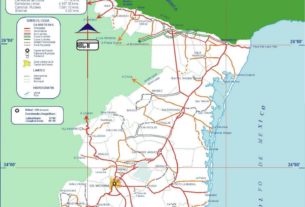The Boat.
If you’re going to sail to Mexico, the size of your boat isn’t nearly as important as the quality. Make sure the boat was designed, built and has been maintained for open-ocean sailing. While Mexico usually has lighter winds than sailors prefer, every couple of years we have to report on a group of boats that got caught in 50 knots of wind and 15-foot seas. Hopefully you won’t ever find yourself in such conditions, but if you do, you don’t want to be trusting your life to a boat designed for lake sailing.
If you own a trailerable boat that wasn’t designed for open-ocean sailing, remember that parts of the Sea of Cortez are ideal for trailerboat sailing. Look for the places that have a large number of anchorages close together, which would mean you never have to wander too far from shelter.
No matter what kind of boat you take to Mexico, check to make sure her basic features, systems and emergency gear are in good working order. After all, you’re better off discovering that the steering cable needs replacement at the dock in California than at 0200 off of Cedros Island when it’s blowing 30 and everyone is already seasick. ‘A stitch in time saves nine’ is for landlubbers. At sea, a stitch can save you from a lot of misery. Specialized marine parts are hard to come by in Mexico, too. So if your gooseneck fails while rounding Cabo Corrientes, you might have blown a month of your precious cruising time.
If you’re unsure of how to evaluate the condition of your hull, thru-hulls, steering system and rudder, propulsion system, mast, rigging, sails and other gear, hire a surveyor. It may turn out to be the best investment you made in your cruise.
Gear.
Despite the fact that many boats heading to Mexico are loaded down with gear, much of it isn’t absolutely necessary. To our mind, the following is the minimum:
EPIRB, Coast Guard required safety gear, liferaft, dinghy (which may be modified to serve as a liferaft), three appropriate size anchors with appropriate size rode, compass, two GPSs, VHF radio, working sails, a light air headsail, some kind of cockpit shading, one set of charts and one cruising guide. Add food and water, and you can enjoy a great minimalist cruise. But whatever you do, don’t go offshore without a 406 EPIRB.
If you’ve still got money left, we suggest you add an electric windlass, depthsounder, radar (which is as good for navigation as it is for avoiding ships in the fog), speed and wind instruments, a top-quality dinghy with an outboard powerful enough to make it plane with two passengers, and a combo SSB/Ham radio.
There’s nothing like cold beers and lots of fresh water when you’re cruising. But while both refrigeration and watermakers are great, remember that in addition to their initial cost, they’ll also increase demands on your boat’s electrical supply and your maintenance time. We think that both refrigeration and watermakers are worth it, but it’s possible to have a great cruise without them.
Skipper and Crew.
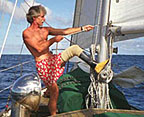 If you’re the skipper, you need to be fully aware that there are significantly greater challenges to cruising in Mexico than there are to sailing across the Bay or on a typical weekend cruise from Marina del Rey to Catalina. You need to be comfortable with night sailing, heavy weather sailing, coastal and offshore navigation, anchoring, and the fatigue that accompanies the first couple of days at sea.
If you’re the skipper, you need to be fully aware that there are significantly greater challenges to cruising in Mexico than there are to sailing across the Bay or on a typical weekend cruise from Marina del Rey to Catalina. You need to be comfortable with night sailing, heavy weather sailing, coastal and offshore navigation, anchoring, and the fatigue that accompanies the first couple of days at sea.
If you don’t have adequate experience, you should strongly consider bringing along a seasoned mentor for your virgin run from San Diego to Cabo. Not only will you get a good education, but the trip should be more relaxing and less stressful. And when you’re finally on your own in Cabo, you’ll have much greater confidence in your own abilities.
Before heading south of the border, the skipper and crew should review all the boat’s emergency gear, systems, and engine controls. It would be a shame if the skipper were to fall overboard in calm conditions and be lost because he/she had neglected to show the rest of the crew how to operate the engine. In addition, a chart indicating the location of all the thru-hull fittings should be posted in an obvious place.
The skipper and crew should practice putting in single and double reefs, preferably at night at sea. The man overboard drill should also be conducted under realistic conditions. You’ll be anchoring all the time in Mexico, so the whole crew should be made familiar with all the gear and techniques – prior to having to set the hook at midnight in Bahia Santa Maria.
If you’re crewing on a boat and the skipper hasn’t gone over all the basic and emergency systems, insist that he/she do so.
While many people have singlehanded to Mexico, it’s safer – and usually more fun – to have at least one other person along with you. If your boat is large enough, a third or fourth person often makes the trip down Baja more of a pleasure cruise. But if there’s just two of you making a quick trip from San Diego to Cabo, expect to be wiped out when you arrive at the Cape. After all, the first couple of days at sea are the hardest on even the most experienced sailors, and 12 hours of watches a day will drain anyone.
Insurance.
There are two types of insurance you’ll want to consider. The first is insurance for your boat in the event that you lose the mast, get blown on the beach or get holed by a shrimper. If your boat is in good condition, you shouldn’t have any trouble getting it. If you already have it, there’s a good chance your insurer will add a Mexico ‘rider’ for a relatively small fee. If we had to guess, we’d say about 50% of the boats cruising Mexico have this kind of insurance.
The other insurance to be considered is Mexican liability insurance. In the unlikely event you do some damage with your boat in Mexico – run over a panga fisherman in the middle of the night, T-bone a shrimper and damage the hull, that kind of thing – you’d better have plenty of cash on hand or Mexican liability insurance. If not, plan on spending time in a Mexican jail.
Liability insurance for Mexico is not expensive, and can be purchased in Mexico or in the States from a broker that deals with boat insurance for Mexico. It’s the kind of thing you probably won’t ever need, but if you do, you’ll be really glad you have it.
Identification, ID Paperwork and such.
Don’t go to Mexico – or take any crew to Mexico – without the following:
Personal ID
– Passports are recommended, but not required. Your original birth certificate or driver’s license are acceptable – if accompanied by a notarized letter which verifies your identification. Be smart, get the passport.
Everyone traveling to Mexico must obtain a Mexican ‘Tourist Card’. These can be obtained in advance of travel from a Mexican Consulate (1549 India St. San Diego, CA 619-231-8414) or many Southland travel agencies. If you are unable to obtain a ‘tourist card’ in advance, no problemo, they’ll have one at your first port of entry. In either case, folks arriving by boat are invariably given a tourist card that’s good for six months. After that, just get it renewed.
Boat Documents
– Every boat must carry vessel documentation which proves ownership and port of registry. If your boat is not a U.S. documented vessel, you must carry registration papers and a bill of sale or other proof of ownership.
Fishing Licenses
– Oddly enough, this is the only paperwork you have to take care of before entering Mexico – on the assumption you’ll be carrying any fishing gear onboard. If you have as little as just a few hooks, you must have licenses for your boat, your dinghy (if you fish from it), and for each of your crew. If you’re caught with fishing gear – you don’t have to be fishing or have a fish onboard – without a license, you’re liable for big fines and having your boat seized. It’s very unlikely you’d be caught, but it could land you in big trouble. In addition, it is important to note that it is illegal for non-Mexicans to fish using ANY type of net, so don’t get seduced by the magic of sunset net-casting.
Mexican fishing licenses are good for one year and can be obtained in San Diego from: Mexican Fisheries office, 2550 5th Ave., Suite 101, San Diego, CA; (619) 233-6956. They’re not cheap, so catch lots of fish.
Radio Licenses
– In addition to having an FCC ship’s station license*, Ham operators would do well to obtain a reciprocal Mexican license. You can get one in Tijuana from the Secretaria de Communicationes y Transportes for a fee of $90. Take two copies of your U.S. Ham license along with two copies of your stamped Tourist Card to: 1071 Calle 16, Libertad (near the intersection of Cajon Azueta and Calle 16); phone: 011-52-668-29500; fax: 011-52-668-23889.
(*For an FCC license you need to complete form FCC 506. The agency may be contacted by calling: (619) 467-0549 or writing: FCC, Marine Ship Service, P.O. Box 358275, Pittsburgh, PA 15251-5275.)
Charts and Cruising Guides.
Charts come in many forms: originals, single reproductions, compilations of reproductions, and electronic. To our mind, there’s nothing like the look, feel and romance of original charts – which unfortunately run $15 or more. As a result, the Yachtsman’s Chart Book and the out-of-print Mexico ChartGuide West compilations are good deals. Another way to go is to buy a couple of large-scale charts and a good cruising guide. When it comes to the Sea of Cortez, Gerry Cunningham markets specialized charts for the more popular areas. Electronic charts offer several advantages, but a ‘hard copy’ backup of some sort is essential.
There used to be a wide selection of cruising guides for Mexico. The Boating Guide to Mexico, by Capts John Rains and Patricia Miller, was the most recent, and probably the best. They hope to have a new edition out in late October 2000. Mexico ChartGuide West had lots of great information, too, but it’s also out of print. The only cruising guide left that covers all of Mexico is Charlie’s Charts. But remember, when ‘Charlie’ and the other authors say their charts are “Not to be used for navigation,” they mean it. Compare the wildly different chartlets of, say, San Juanico, in the Boating Guide, Mexico Chart Guide, and Charlie’s Charts and you’ll see what we mean.
A couple of years ago, we used Charlie’s Ixtapa / Z-town ‘chartlet’ to make a nighttime approach to Z-town. We would have driven right up on unlit Sacramento Reef had we not been double-checking Charlie against ChartGuide West and the Boating Guide to Mexico – because Charlie left the reef out!!! Always try to rely on more than one source of navigational information.
Be warned also, that while GPS is very accurate, hard charts sold today are often based on data that is more than 100 years old, and are not accurate.
When it comes to Baja, Jack Williams has the Pacific Coast covered in Baja Boater’s Guide, Volume 1 – the Pacific Coast; and the Sea of Cortez coast of Baja covered in Baja Boater’s Guide, Volume II – The Sea of Cortez. We particularly like the aerial photographs of most anchorages and important points. Gerry Cunningham has authored three guides for the most popular areas of the Sea of Cortez.
While the cruising guides offer some historical and cultural information, nothing can compare with the incredibly informative general tourist guides to Mexico published by Moon Publications and/or Lonely Planet. While a combination of their Baja Handbook and Pacific Mexico Handbook will do the job, they also offer handbooks for Cabo and Puerto Vallarta. We’d say the first two, at about $15 each, are ‘must buys’ to fully appreciate Mexico.
While lots of folks read trashy novels in Mexico, there are three classic books you shouldn’t miss: The Log of the Sea of Cortez by John Steinbeck, The Pearl by John Steinbeck, and Karl Franz’ People’s Guide to Mexico. If you’re confused by Mexican culture, Franz’ book – now in its 25th edition – will explain it in a most entertaining manner.
II. Weather
 When it comes to cruising climates, there are really two different areas of Mexico. One is the Sea of Cortez, where the air and water are not tropical in the winter. The other area is – depending on your standard of warmth – from Mazatlan or Puerto Vallarta south, where it’s always tropically warm.
When it comes to cruising climates, there are really two different areas of Mexico. One is the Sea of Cortez, where the air and water are not tropical in the winter. The other area is – depending on your standard of warmth – from Mazatlan or Puerto Vallarta south, where it’s always tropically warm.
Air temperatures in the Sea of Cortez can be cool from as early as mid-November until March or April. And it can get downright cold when a Norther roars down from the States. However, since the Sea of Cortez pretty much runs north-south for about 550 miles, there is great variation in the effect of Northers and the air temperature. When a Norther is blowing 40 knots and it’s very chilly in Conception Bay, for instance, it might only be blowing 15 and be just a little cool in La Paz.
The exceptions to Sea of Cortez weather are Cabo and Mazatlan, both of which stay warm all year round. Mazatlan is affected by only the strongest Northers, while Cabo is immune because of tall mountains.
Water Temperatures.
While there can be spells of cool and cold air temperatures in the Sea of Cortez as early as November, the water temperature normally stays quite warm as late as early December. We once recorded 88° at Isla Partida during Thanksgiving. After that, the water temperature cools rapidly and dramatically, so forget swimming from La Paz north until March or April.
The bottom line is that the best times to cruise the fabled Sea of Cortez are the spring and fall. Winter is too cool for those who enjoy water sports and enjoy a good tan. Summer can be very warm – August and September are hot as Hades – but lots of folks still love it.
South of Mazatlan or Puerto Vallarta, the air and water temperatures are pleasant all year round. While some Northers blow down as far south as Mazatlan, they never reach Puerto Vallarta.
But if you like real heat in the winter, there’s nothing like getting as far south as Z-town. At midnight one memorable New Year’s Day, we measured both the air and sea temperatures at 80°. And for some reason, the skies are almost always blue in Z-town.
Nasty Weather.
While the sailing winds in Mexico are normally light and benign during the prime cruising season between November and June, there are some notable exceptions. The Pacific Coast of Baja is periodically subject to strong winds from the north, northwest, and east, as well as the even more dreaded ‘Pineapple Expresses’ from Hawaii. See Jack Williams’ Baja Guide for the best shelters for the different conditions.
 The Sea of Cortez can also be dangerous from November to March as Northers howl down from the States on a semi-regular basis. It’s not uncommon to have 40 or more knots of wind during a Norther, but worse still, the seas quickly build to surprising heights. These seas are unusually dangerous because they are so steep and close together. When there’s a Norther blowing, you want to be holed up in a snug anchorage. And don’t cross the Sea of Cortez without checking for a Norther.
The Sea of Cortez can also be dangerous from November to March as Northers howl down from the States on a semi-regular basis. It’s not uncommon to have 40 or more knots of wind during a Norther, but worse still, the seas quickly build to surprising heights. These seas are unusually dangerous because they are so steep and close together. When there’s a Norther blowing, you want to be holed up in a snug anchorage. And don’t cross the Sea of Cortez without checking for a Norther.
The number of Northers during any given winter can vary tremendously. Sometimes there seems to be one after another, other years there are hardly any.
Hurricanes.
The hurricane season in Mexico is roughly from June 1 until October 31. During the last 50 years there have been a handful of Mexican hurricanes in the month of November, none of which would have affected cruisers. There was, however, one nasty hurricane in the middle of December – so you never can tell.
The Jack Williams’ cruising guides to the Sea of Cortez list the probability of hurricanes by months, but the data is somewhat out of date. If you want to be an authority on Mexican hurricanes, go to: https://wxp.atm.purdue.edu/hurricane/e_pacific/index.html. This site has all the data, plus a color coded chart showing the windspeed and path, from every Mexican tropical storm and hurricane since 1949. It’s the greatest.
In the summertime, the Sea of Cortez is also subject to chubascos – brief storms appearing out of nowhere with winds that often blow at close to hurricane force. In the fall of ’97, a number of cruising boats were driven ashore at Puerto Escondido by a chubasco.
Best Sailing Wind.
Banderas Bay has the most consistent sailing breeze in Mexico. It blows about 15 knots almost every day from about 11 a.m. to 4 p.m.
Most Annoying Wind.
Coromuels come up in the middle of the night and blow out of La Paz – and into the normally protected coves of Isla Partida. If you’re on the hook out there, they can drive you nuts, because they die the next morning just as you’re ready to go sailing.
For a more thorough picture of Mexican weather, check out Capt. John Rains’ MexWX.
III. Typical Itineraries
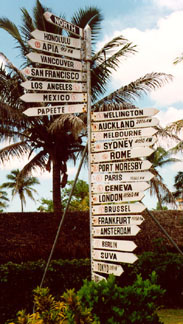 While some may disagree with us, we think it’s best to leave San Diego immediately after the end of the hurricane season. In so doing, you normally avoid bad weather coming down the west coast of the United States, avoid real bad weather off the coast of Baja, and have the longest cruising season. As such, all our itineraries are based on getting south to Cabo by mid-November.
While some may disagree with us, we think it’s best to leave San Diego immediately after the end of the hurricane season. In so doing, you normally avoid bad weather coming down the west coast of the United States, avoid real bad weather off the coast of Baja, and have the longest cruising season. As such, all our itineraries are based on getting south to Cabo by mid-November.
Six Month Itinerary.
Hurry down the coast of Baja, have a beer and a shower in Cabo, then hustle up to the islands just north of La Paz. Once in this fine cruising area, kick back into cruising mode and enjoy the area for as long as the water stays warm and the Northers don’t blow. In a typical year, you’ll still want to head over to Mazatlan by early December. From Mazatlan, we recommend hauling butt south so that you make it to Z-town for Christmas and New Year’s. Yes, it requires covering quite a few miles.
After spending a month to six weeks in the Z-town / Acapulco region, you should slowly start working your way north, remembering that the great Banderas Bay Regatta for cruisers takes place in late March. In late March or early April, you should cross from Mazatlan to La Paz, remembering that Sea of Cortez Sailing Week is usually held in late April. From then on, continue enjoying the Sea of Cortez as far north as the water temperature and your schedule allow. Most cruisers have the option of heading home via Cabo and the ‘Baja Bash’, or sailing to San Carlos and having their boat trucked back to the States.
The above six-month itinerary is for those who prefer warmer weather and don’t mind moving smartly for brief spells. If you prefer to mosey or get a late start, skip the first foray into the Sea of Cortez and sail directly from Cabo to Puerto Vallarta. If you really like to mosey, skip the Sea of Cortez and don’t sail south of Manzanillo.
One Year Itinerary.
Take your own sweet time sailing down to Cabo, have a beer and a shower, then sail across to Puerto Vallarta. Allocate five months to enjoy the mainland between Acapulco and Mazatlan, remembering that the real heat is down south by Z-town. In late March or early April, cross into the Sea of Cortez and spend the rest of your time there. Lots of cruisers take a ‘vacation’ from cruising in August and September when it’s so very hot in the Sea of Cortez. Come November, either sail or truck your boat home. By the way, November is normally the best month to do the ‘Baja Bash’ back to California. March and April, when the northwesterlies really blow, is usually the worst.
If you have one year and you want to enjoy more than Mexico, do the six-month itinerary outlined above, then sail to either French Polynesia or Hawaii for a couple of months, then to British Columbia until late fall. Several folks who have done circumnavigations tell us that this is the best 12 months to be found anywhere in the world.
Best Cruising Grounds.
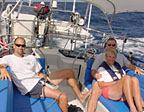 Most Mex vets would vote for the 140 miles of islands and isolated anchorages between La Paz and Puerto Escondido, and/or the 175 miles of fine cruising between Puerto Vallarta and Manzanillo. Both are ideal for having guests aboard, as they can be covered in a week, and there are airports at both ends of each. As mentioned before, the Sea of Cortez is not recommended in winter and the mainland less recommended in summer.
Most Mex vets would vote for the 140 miles of islands and isolated anchorages between La Paz and Puerto Escondido, and/or the 175 miles of fine cruising between Puerto Vallarta and Manzanillo. Both are ideal for having guests aboard, as they can be covered in a week, and there are airports at both ends of each. As mentioned before, the Sea of Cortez is not recommended in winter and the mainland less recommended in summer.
Cruisers’ Most Popular Spot.
Z-town wins hands down. True, it’s about 1,400 miles south of San Diego and 780 miles south of Cabo, but few cruisers who’ve gone the distance regret it.
Area with Most Things to Do.
Banderas Bay has wonderful sailing conditions, a variety of great destinations within the Bay, and a city, Puerto Vallarta, that has just about everything you could need – and all the social life you can handle.
IV. Once You’re In Mexico
Clearing.
Whenever you stop at an official port of entry – if sailing from Southern California, the first will almost certainly be Ensenada, Cedros Island, San Carlos (inside Mag Bay) or Cabo San Lucas – you’re required to clear in and clear out with Immigration, the Port Administration – if there is one – and the Port Captain.
First, bring your vessel documentation, passports and ‘tourist cards’ (if you’ve already got them) for all crew, plus five copies of your crew list to Immigration. (The ‘crew list’ is also known as the Rol de Tripulantes, and if you’re clever, you can use the form at the end of this pamphlet by copying and enlarging it.)
In places where you have to pay a Port Fee – such as Cabo, La Paz and others – you have to pay this to the proper agency – which may differ depending on where you are. Immigration will tell you if and where. Once you get a receipt for port fees, you may have to go back to Immigration.
Your final stop will be the Port Captain’s Office. Bring all your paperwork.
When you want to leave, or if you change crew, you get to do the dance all over again. Or, you can pay an agency – usually in or near a marina – to do the work for you. A typical fee is between $20 and $50.
Be warned that normal hours of business at Immigration and Port Captain offices are between 8 a.m. and 3 p.m., Monday through Friday. However, irregular hours, lots of holidays and absent officials frequently screw up the process. Overtime charges may be assessed for checking in after hours, so wait until they open. It’s usually no problem going ashore if you check in within 24 hours.
Since the rules and habits of local officials differ widely, always ask other cruisers or listen to the local net for the latest clearance procedures.
Suppose you’ve checked out of Cabo, but Britany Spears hits on you in Squid Roe and wants to be your galley slave for the trip up to La Paz. Legally, you’re supposed to go through the whole process again to add her name. In reality, some Mexico vets would shine it on. Proceed at your own risk.
Most Mexican officials are pretty flexible. Two winters ago, for instance, we checked out of Cabo for San Diego – then showed up in Mazatlan. This wasn’t proper, of course, but we smiled and explained to the officials that we decided we’d much rather be in Mazatlan than in San Diego. It made perfect sense to them and was no problemo. If you politely approach an official and say, “I have a very big problem,” things can usually be worked out.
Twenty-Year Import Permit.
If you intend to sail to the Mexican mainland and/or leave your boat in Mexico for longer than six months, you’ll need to obtain a ’20-Year Temporary Import Permit’. Twenty years is “temporary”? Once obtained, this permit allows you to cruise in and out of Mexico for up to 20 years without having to leave the country. Not too many years ago, foreign boats were supposed to leave every six months.
While you don’t need to apply for this permit until your initial six months is about to run out, many cruisers get them sooner because having one theoretically exempts you from having to pay duty on replacement parts for your boat. There has been great confusion about what the 20-Year Import Permit allows you to bring in, and how you’re to go about bringing stuff in. Many cruisers have behaved as though the permit gave them carte blanche to import anything they wanted into Mexico duty free. This is wrong, wrong, wrong – and has gotten several cruisers into very serious trouble.
For details on this important issue, see page 130 of Sightings and page 237 of Changes in Latitudes in the September ’98 issue of Latitude 38. But be prepared for policy changes too.
Leaving Your Boat in Mexico.
If the legal owner of a boat wants to leave her in Mexico while he/she returns home, the vessel must – in theory, at least – be left in the care of someone else, such as a friend or a marina. If this is the case, you’ll need to fill out a ‘Certificate Maritime Letter of Permission’. Ask at any marina.
If you’re going to leave your boat with a friend and want him/her to move it, make sure you give your friend a letter – with all the pertinent information – authorizing it.
V. Dealing With Officials
The key to getting official business taken care of quickly in Mexico is to act as though you have all the time in the world. Mexicans view time as being infinite, and even business meetings as being social occasions. So it’s often wise to begin with a bit of small talk – about the weather, the guy’s children, his shirt – whatever. Above all, smile and be patient – because if you rush, the official will be insulted and stall you in ways you can’t even begin to imagine.
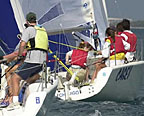 If you get on the wrong side of an official, he’ll usually get back at you in one of two ways: 1) Make you come back the next day, or 2) Make you fill all the forms out again for some completely insignificant reason.
If you get on the wrong side of an official, he’ll usually get back at you in one of two ways: 1) Make you come back the next day, or 2) Make you fill all the forms out again for some completely insignificant reason.
Also remember that different Port Captains and Immigration officials obey different sets of official and unofficial rules. Hey, it’s Mexico! Sometimes agencies or marinas that do paperwork for a fee are able to get the rules interpreted differently.
Dress to Impress.
To a much greater extent than in the United States, officials will treat you according to the way you dress and behave. If you dress like you’re an important person, you’ll usually be treated accordingly. But if you dress like a bum, don’t be surprised to be treated that way. It’s not the end of the world if you dress in the ‘cruisers’ uniform’ of shorts, faded t-shirt and flip-flops, but it doesn’t get you any favors, either.
If you’re a woman who enjoys wearing sexy outfits or displaying breast augmentation with a skimpy bathing suit, you won’t have any problems within tourist areas or resort marinas. But when you venture off into ‘real’ Mexico, you should avoid hassles by dressing conservatively. Similarly, going naked is lots of fun, but Mexico isn’t the South of France. So go starkers on your boat when you’re anchored way out or on some isolated beach. Caution: ‘Mexican eyes’ are everywhere.
VI. Marinas in Mexico
At last count, there were about 2,600 berths in 19 marinas along the west coast of Mexico between Ensenada and Huatulco. See page 13 for the contact numbers and e-mail addresses. Caution: they frequently change.
Berthing is not cheap in Mexico, so it’s nice that just about everything else is a bargain.
VII. Anchoring
Mexico is blessed with a great number of anchorages and generally excellent anchoring conditions. Little Isla Partida, just up from La Paz, for example, has more good anchorages than the entire Hawaiian chain. If you can successfully anchor in the Channel Islands or Hawaii, Mexico will be a cinch. But Mexico will not prepare you for the deep-water anchoring and coral conditions of the South Pacific.
Anchoring etiquette requires that you treat others the way you’d like to be treated – you know, the Golden Rule. So unless specifically invited to anchor next to someone, assume that you should give them as much space as possible. And unless an anchorage gets extremely crowded, don’t anchor directly upwind of another boat.
By the same token, if you get to an anchorage first, don’t be a hog by putting out 10:1 scope. And if an anchorage starts to get crowded, actively try to help newcomers find a good spot rather than pretending they don’t exist. It’s not only the nice thing to do, but what goes around comes around.
If you’ve got a generator or like to play your stereo loud, remember that noise carries great distances over water. Respect the fact that most cruisers appreciate tranquility.
VIII. Cruising Happiness and Cruising Blues
Cruising rarely turns out to be how first-timers imagined it. Not necessarily better or worse, just different. The keys to enjoying cruising are realizing that it takes time to adapt to an entirely new lifestyle and to sloooooow down. This is particularly true for folks who’ve sold everything to go off on a 10-year cruise, because they’ve heaped a ton of pressure on themselves to like it.
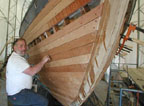 Sometimes the best thing cruisers can do after a couple of months is take a ‘vacation’ from cruising. Put the boat in a marina and return home to see family and friends – and to be reminded why it was they wanted to leave in the first place. Being back in the States for a week or two is usually enough to send once reluctant cruisers scurrying back to their boats.
Sometimes the best thing cruisers can do after a couple of months is take a ‘vacation’ from cruising. Put the boat in a marina and return home to see family and friends – and to be reminded why it was they wanted to leave in the first place. Being back in the States for a week or two is usually enough to send once reluctant cruisers scurrying back to their boats.
If you’re a couple, be more forgiving of one another than normal, for both of you have all kinds of new responsibilities and anxieties. Sticking through the tough times often makes couples closer. And if you’re a gung-ho male sailor with a novice girlfriend or wife, the dumbest thing you could do is scare the hell out of her. Give her time to ease into sailing – or let her take a plane on the long passages.
Ultimately, the biggest killer of cruising dreams seems to be alcohol. Booze is cheap in Mexico and the climate is conducive to sipping all day and half the night. The number of Americans – mariners and non-mariners alike – who are living out their lives in an alcoholic haze in Mexico is tragic. If you drink, periodically stop to evaluate whether booze is controlling your life. The good news is that there are AA meetings and other support groups just about everywhere Americans gather.
IX. Odds and Ends
Money.
When it comes to major expenses – berthing, fuel, and tourist bars and restaurants – credit cards are almost universally accepted. But don’t even think of pulling out your American Express platinum card – or even traveller’s checks – at some little bodega .
There are ATMs in all sizeable Mexican cities, but cruisers periodically have reported getting ripped off by them. Unless you’re a free-spender who likes hanging around the bright lights of tourist areas, you’ll be surprised at how little cash you need. Want to try something really fun? See if you can make it through an entire month without spending a centavo. It’s actually easy to do.
To give you an economic frame of reference, the minimum daily wage in Mexico is $3 U.S. That’s daily, not hourly.
Staying In Touch.
If you’re one of those people who likes to stay in touch with your family, friends and business, there are many ways to communicate back to the States.
There are telephones just about everywhere in Mexico – but always ask questions about cost before using them because you can really get hosed – like paying $7 per minute!
Those with ham radios can use the various nets to get ‘phone patches’ back to the States. You can’t conduct business on ham radio, so if you have an SSB/Ham combo, nonprofit SailMail – developed by racer/cruisers Stan Honey and Jim Corenman of Northern California – is perhaps the easiest and least expensive way to send e-mail around the Pacific and – depending on the propagation – to the Caribbean. Visit www.sailmail.com.
Don’t leave your cell phone at home, as many cruisers use them and Mexican AOL accounts to send and receive e-mail and to maintain Web sites.
If you have $3,000 to $5,000 to stay in touch, Inmarsat C has always been popular, but it only gives you text. Iridium satellite phones are now defunct, but Qualcomm-Globalstar has a new satellite system we’ll be testing during the Ha-Ha.
One of the great reasons to go cruising is to avoid the overload of information. While trying a ‘no money month’, why not try a ‘incommunicado month’, too?
Guns and Drugs.
There are currently about 70 Americans in Mexican jails because they inadvertently brought guns or bullets into Mexico. Given Mexico’s history with revolutions, banditos and drug runners, they show no mercy on those who violate their strict laws. As little as one bullet can get you up to five years – after you’ve waited as much as a year to stand trial.
We’ve never brought guns or bullets to Mexico, and we never felt as though we needed them. If push came to shove, we suppose we’d try to fake it with our flare guns.
Drugs.
Messing around with any amount of drugs in Mexico is dangerous. When it comes to large quantities, life is cheap – as evidenced by the 22 people murdered in Ensenada in ’98. And even when it comes to small amounts, there is the possibility you’re dealing with the wrong kind of people or are being set up. The penalties for being caught with even a small amount of pot are severe, and Mexican courts don’t let the accused or their lawyers jive ass their way out of situations the way U.S. courts do.
Cruiser Code of Conduct.
If there was one, it would be based on the Golden Rule and the Caribbean motto: “Take only photos and leave only footprints.”
Getting Wild and Crazy.
Just about everybody needs to get wild and crazy from time to time. Fortunately, in any large Mexican tourist area there are designated bars for Americans to get drunk and behave like complete idiots. Our post Ha-Ha favorite has always been Squid Roe in Cabo, where everyone is relentlessly encouraged to get bombed, do lascivious things with consenting partners, and generally misbehave in a controlled environment. Caution: Do not try this behavior in a authentic Mexican cantina. In fact, do yourself a favor and stay out of authentic cantinas.
Toilet Paper.
Between Montezuma’s revenge and the lack of well-stocked restrooms, it never hurts to carry a little on your person.
X. The Most Common First-Timer Mistakes
1) Wrongful anchoring.
The two main causes of faulty anchoring – which causes untold anxiety and sleepless nights – are: inadequate equipment and poor technique.
As Einstein noted, everything is relative. So what looks like an enormous anchor and monster rode sitting on a shelf in a chandlery looks like toy stuff when trying to hold a 12-ton boat off a lee shore in a 40-knot blow. There are places where you can skimp on your cruising budget, but anchors and rodes are not one of them. Buy big and buy extra. And don’t forget the windlass and chafe gear.
The good news about Mexico is that other than at Cabo, where the outer harbor is an uphill sand bottom, and La Paz, where the famous tidal waltz has boats drifting about in all directions, the anchoring conditions are generally very good.
Of course, even the biggest anchor and strongest rode won’t do you any good if you don’t know how to use them. Throwing the anchor and rode over the side in a bundle while still moving forward is a recipe for disaster. Such a mess will hold in light wind, but as soon as you go to sleep and the breeze comes up, you’ll drag right through the fleet.
In most conditions, the proper anchoring technique is to back down at a slow but constant speed, getting the rode to lay out in a straight line. When you get the proper length down, you gradually increase your power in reverse, allowing the anchor to slowly but surely dig in.
2) Dinghy Deficit.
When cruising Mexico, your dinghy is not some indulgent toy, but your lifeline with both the shore and greater adventures. For some cruisers, it’s their liferaft, too. In our opinion, you need a top-quality dinghy with an outboard powerful enough to plane while carrying the number of people in your crew. That means 6 hp for one, 10 hp for two, and 15 hp for three. A good dinghy and outboard combination is expensive, but if you take decent care of it, it should last for five years and still have good resale value. A serviceable second dinghy of some sort is a godsend for boats with larger crews.
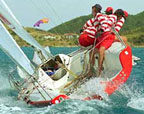 Because you’ll make so many surf landings in Mexico, make sure your dinghy is equipped with wheels. You probably won’t use the wheels anywhere else, but they’re worth it for Mexico alone.
Because you’ll make so many surf landings in Mexico, make sure your dinghy is equipped with wheels. You probably won’t use the wheels anywhere else, but they’re worth it for Mexico alone.
3) Reefing Madness.
Far too many people sail to Mexico without having a ‘clew’ about how to properly reef or heave to. Reefing is essential for safety and comfort. And it’s useless to practice at the dock, because it’s an entirely different experience during a storm at night at sea. If you sail shorthanded, reefing at night is not a bad strategy. Sometimes folks heave to in even light conditions just to catch some rest or even a meal.
4) Over-Provisioning.
There’s not a significant food product you can’t find in Cabo, La Paz, Mazatlan, Puerto Vallarta, Manzanillo or Acapulco. So why cruisers continue to load up with six month’s worth of goods at Costco in San Diego is beyond us. The stuff takes up valuable storage space, overloads the boat, and too much of it goes to waste.
5) Electrical Shortages.
The majority of first-time cruisers to Mexico greatly underestimate the electrical needs of all the new gear they’ve had installed. Transmitting on SSB or Ham, for example, can really drain a battery. So can refrigerators working in tropical heat and watermakers trying to filter the high salinity water of the Sea of Cortez. The only two solutions are to limit electrical consumption or increase capacity.
6) Health Kick.
While the climate in Mexico is great for drinking, it’s even better for the healthy outdoor life and getting yourself into better shape than you’ve been in years. We all know the formula: walk a couple of miles a day, swim a mile a day, eat well and drink in moderation. And we all know the results: less weight, lower blood pressure, greater endurance, wilder sex, and better general health.
7) Make the Most of Cruising.
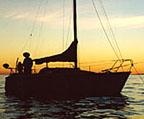 We suggest that everyone about to take off cruising take full advantage of the opportunity. In addition to getting your body into great shape, open your mind by doing a variety of activities in addition to sailing, diving, hiking, swimming and exploring. The Moon Publication handbooks are great for things you might not have thought of.
We suggest that everyone about to take off cruising take full advantage of the opportunity. In addition to getting your body into great shape, open your mind by doing a variety of activities in addition to sailing, diving, hiking, swimming and exploring. The Moon Publication handbooks are great for things you might not have thought of.
While in Mexico, interact as much as possible with the locals, for they are wonderful people.
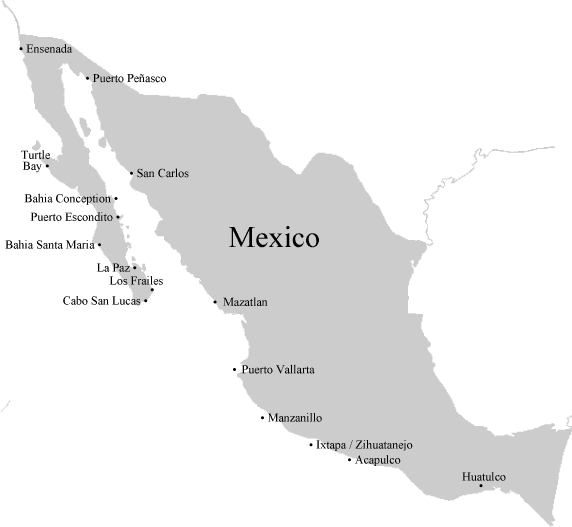
Approximate Distances in Nautical Miles:
San Diego to Turtle Bay: 360
Turtle Bay to Bahia Santa Maria: 240
Bahia Santa Maria to Cabo: 180
Cabo to Frailes: 45
Cabo to La Paz: 148
La Paz to Puerto Escondito (Loreto): 140
Puerto Escondito to Conception Bay: 105
Conception Bay to San Carlos: 80
La Paz to Mazatlan: 230
Cabo to Mazatlan: 200
Mazatlan to Puerto Vallarta: 175
Cabo to Puerto Vallarta: 295
Puerto Vallarta to Manzanillo: 175
Manzanillo to Z-town: 190
Z-town to Acapulco: 115
Mexican Ports of Entry
Ensenada, Baja
Cabo San Lucas, Baja
Cedros, Baja
San Carlos, Baja
Loreto, Baja
Santa Rosalia, Baja
Guaymas, Sonora
Topolobamba, Sonora
Mazatlan, Sinaloa
San Blas, Nayarit
Chacala, Nayarit
Puerto Vallarta, Jalisco
Manzanillo, Guerero
Zihuatanejo, Guerero
Acapulco, Guerero
Puerto Angel, Oaxaca
Salina Cruz, Oaxaca
Produced by the staff of Latitude 38 who remind you to ‘keep in touch’ during your travels. We encourage you to write us with reports (with photos!!!) about interesting places you visit, or letters about issues of interest to other cruisers.
© Latitude 38 Publishing Co., Inc., 1998-2001
Published or Updated on: January 1, 2006

